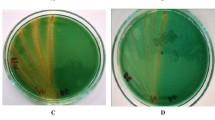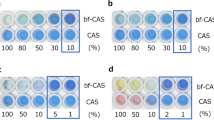Abstract
Universal CAS-Agar Plate Assay for Detection of Siderophore Producing Microorganisms: Siderophores are low-molecular-weight (<1000 Da), Fe (III)-specific ligands that can chelate iron compounds with high affinity. Siderophores are secondary metabolites assembled by non-ribosomal cytoplasmic peptide synthases. Functional groups and lateral chains of siderophore confer a strong affinity toward ferric ion. The affinity of siderophores ranges from low (aerobactin) to high (enterobactin). These compounds are typically produced by various bacteria, fungi, and monocotyledonous plants in response to iron stress. Generally, iron has vital functions in photosynthesis, enzyme cofactor, redox reagent, respiration, synthesis of nucleosides, and amino acids of the living system. Apart from the above functions, siderophores also act as plant growth promoters, biocontrol agents, and bioremediation, in addition to soil mineral weathering. In spite of the concentration of Fe, iron deficiency is induced in plants grown under alkaline soils. Affinity of the plant for Fe is decreased in calcareous soils and impedes iron uptake mechanism.
Based on the coordinating groups that chelate the Fe (III) ion, siderophores are generally classified into catecholates, hydroxamates, and carboxylates. Along with this, other types of siderophores have chemically distinct Fe (III) ion binding group and mixed ligands having coordinating groups that fall into chemically different classes. These groups are usually identified based on their electrophoretic mobility, spectrophotometric titration, proton nuclear magnetic resonance spectroscopy, mass spectrometry, acid hydrolysis, and biological activity.
Modified CAS-Agar Plate Assay for Detection of Siderophore Producing Fungi and Bacteria: The concentration of HDTMA and CAS is crucial for siderophore medium preparation. The lower concentration leads to precipitation of the blue dye and higher concentration may turn toxic to all organisms. To avoid this, universal CAS-agar plate assay (Schwyn and Neilands, Anal Biochem 160:47–56, 1987) was modified (Milagres et al., J Microbiol Methods 37:1–6, 1999) to test siderophore producing ability of several fungi and gram-positive bacteria.
O-CAS Assay for Fast Universal Method to Detect Siderophore Producing Microorganisms: O-CAS means “Overlaid—CAS” assay used for the detection of siderophore producing microorganisms from any samples. This method is used for the detection of more than one siderophore producing microorganism. By adjustment of medium composition, detection is optimized. In the existing CAS universal assay method, the medium not only has the required nutrients, some microorganisms (especially gram-positive bacteria and fungi) are unable to grow due to the presence of inhibitory substances.
Layer Plate CAS Assay for Determining Fungal Siderophores: Hexadecyl tri-methyl ammonium bromide (HDTMA) in CAS assay inhibits the growth of many fungi. N-dodecyl-N, N-dimethyl-3-ammonio-1-propanesulfonate (DDAPS) is less toxic to fungi compared to HDTMA and produces results similar to CAS assay with HDTMA. Hence, DDAPS replaces HDTMA as surfactant in CAS medium. Petri plates having AY + CAS assay solution overlaid with AY agar medium are used for better growth of yeast and fungi.
Access this chapter
Tax calculation will be finalised at checkout
Purchases are for personal use only
Similar content being viewed by others
References
Louden BC, Haarmann D, Lynne AM (2011) Use of blue agar CAS assay for siderophore detection. J Microbiol Biol Educ 12(1):51–53
Schwyn B, Neilands JB (1987) Universal chemical assay for the detection and determination of siderophores. Anal Biochem 160:47–56
Andrews MY, Santelli CM, Duckworth OW (2015) Layer plate CAS assay for the quantitation of siderophore production and determination of exdutation patterns for fungi. J Microbiol Methods 121:41–43
Milagres AM, Machuca A, Napoleao D (1999) Detection of siderophores production from several fungi and bacteria by a modification of chrome azurol S (CAS) agar plate assay. J Microbiol Methods 37:1–6
Hu QP, Xu JG (2011) A simple double-layered chrome azurol S agar (SDCASA) plate assay to optimize the production of siderophores by a potential biocontrol agent Bacillus. Afr J Microbiol Res 5:4321–4327
Author information
Authors and Affiliations
Rights and permissions
Copyright information
© 2021 Springer Science+Business Media, LLC, part of Springer Nature
About this protocol
Cite this protocol
Senthilkumar, M., Amaresan, N., Sankaranarayanan, A. (2021). Detection of Siderophore Producing Microorganisms. In: Plant-Microbe Interactions. Springer Protocols Handbooks. Humana, New York, NY. https://doi.org/10.1007/978-1-0716-1080-0_47
Download citation
DOI: https://doi.org/10.1007/978-1-0716-1080-0_47
Published:
Publisher Name: Humana, New York, NY
Print ISBN: 978-1-0716-1079-4
Online ISBN: 978-1-0716-1080-0
eBook Packages: Springer Protocols




